Tourist Operations Management: Analysing Trends, Developing Holidays, and Strategic Decisions
VerifiedAdded on 2024/06/11
|18
|4605
|87
AI Summary
This study delves into the dynamic world of tourist operations management, examining the impact of current trends on the tour operator industry. It explores the stages and timescales involved in developing holiday packages, evaluating different contracting methods and calculating selling prices. The study also analyzes the planning decisions behind brochure design, assesses alternative distribution methods, and evaluates strategic and tactical decisions made by various tour operators. Through a case study of Thomas Cook, the paper provides insights into the complexities of managing tourist operations in a competitive market.
Contribute Materials
Your contribution can guide someone’s learning journey. Share your
documents today.
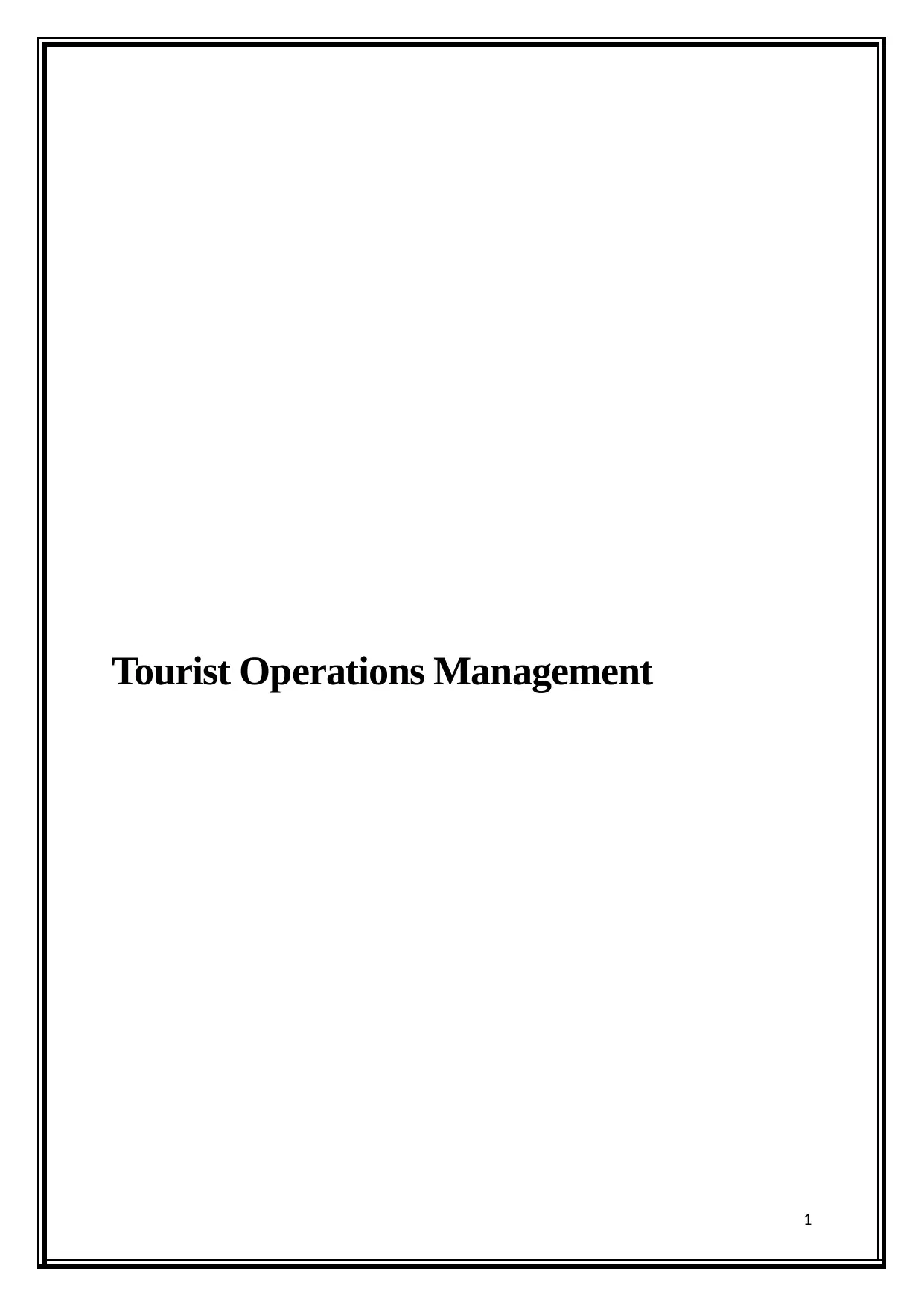
Tourist Operations Management
1
1
Secure Best Marks with AI Grader
Need help grading? Try our AI Grader for instant feedback on your assignments.
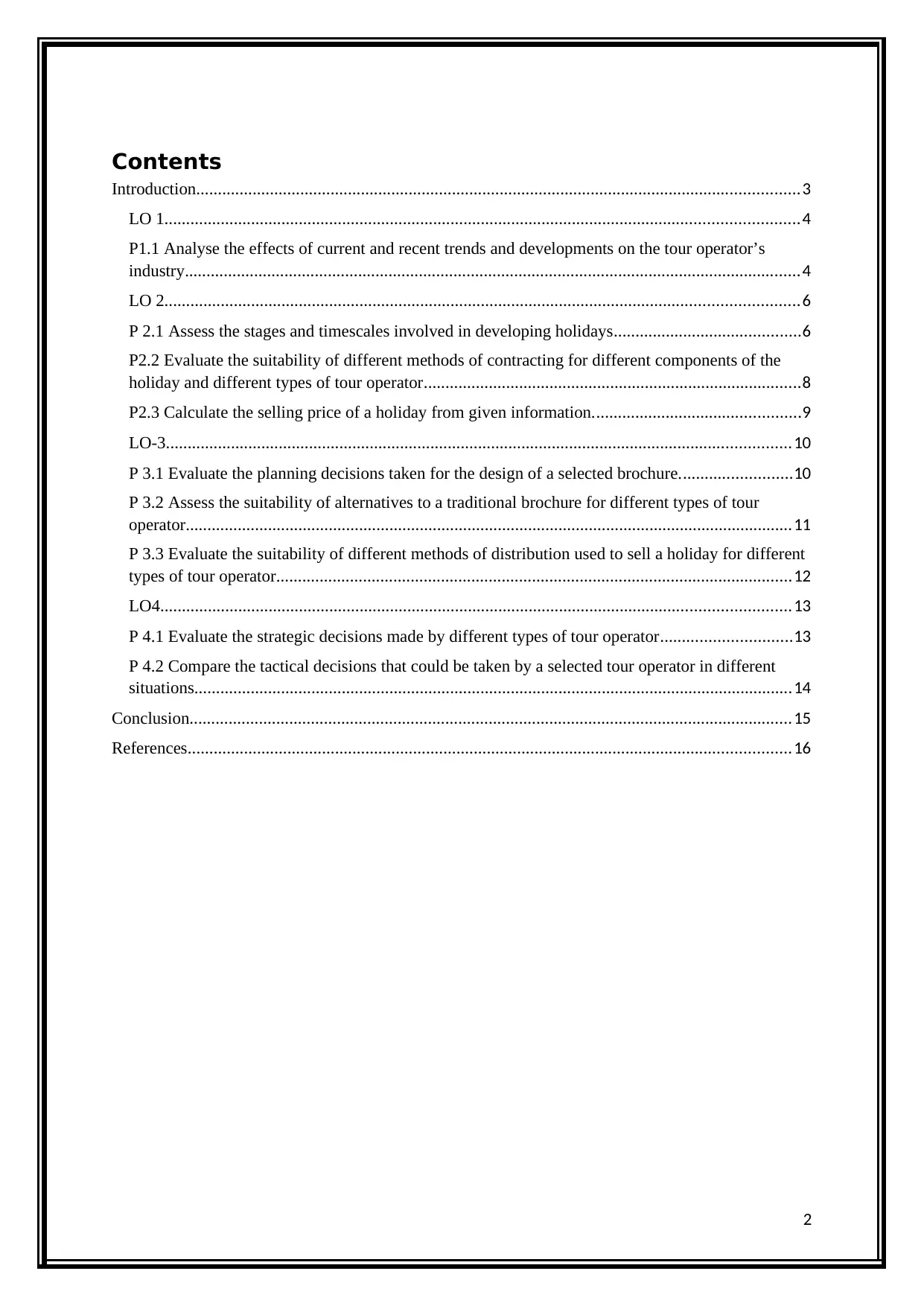
Contents
Introduction...........................................................................................................................................3
LO 1..................................................................................................................................................4
P1.1 Analyse the effects of current and recent trends and developments on the tour operator’s
industry..............................................................................................................................................4
LO 2..................................................................................................................................................6
P 2.1 Assess the stages and timescales involved in developing holidays...........................................6
P2.2 Evaluate the suitability of different methods of contracting for different components of the
holiday and different types of tour operator.......................................................................................8
P2.3 Calculate the selling price of a holiday from given information................................................9
LO-3................................................................................................................................................10
P 3.1 Evaluate the planning decisions taken for the design of a selected brochure..........................10
P 3.2 Assess the suitability of alternatives to a traditional brochure for different types of tour
operator............................................................................................................................................11
P 3.3 Evaluate the suitability of different methods of distribution used to sell a holiday for different
types of tour operator.......................................................................................................................12
LO4.................................................................................................................................................13
P 4.1 Evaluate the strategic decisions made by different types of tour operator..............................13
P 4.2 Compare the tactical decisions that could be taken by a selected tour operator in different
situations..........................................................................................................................................14
Conclusion...........................................................................................................................................15
References...........................................................................................................................................16
2
Introduction...........................................................................................................................................3
LO 1..................................................................................................................................................4
P1.1 Analyse the effects of current and recent trends and developments on the tour operator’s
industry..............................................................................................................................................4
LO 2..................................................................................................................................................6
P 2.1 Assess the stages and timescales involved in developing holidays...........................................6
P2.2 Evaluate the suitability of different methods of contracting for different components of the
holiday and different types of tour operator.......................................................................................8
P2.3 Calculate the selling price of a holiday from given information................................................9
LO-3................................................................................................................................................10
P 3.1 Evaluate the planning decisions taken for the design of a selected brochure..........................10
P 3.2 Assess the suitability of alternatives to a traditional brochure for different types of tour
operator............................................................................................................................................11
P 3.3 Evaluate the suitability of different methods of distribution used to sell a holiday for different
types of tour operator.......................................................................................................................12
LO4.................................................................................................................................................13
P 4.1 Evaluate the strategic decisions made by different types of tour operator..............................13
P 4.2 Compare the tactical decisions that could be taken by a selected tour operator in different
situations..........................................................................................................................................14
Conclusion...........................................................................................................................................15
References...........................................................................................................................................16
2
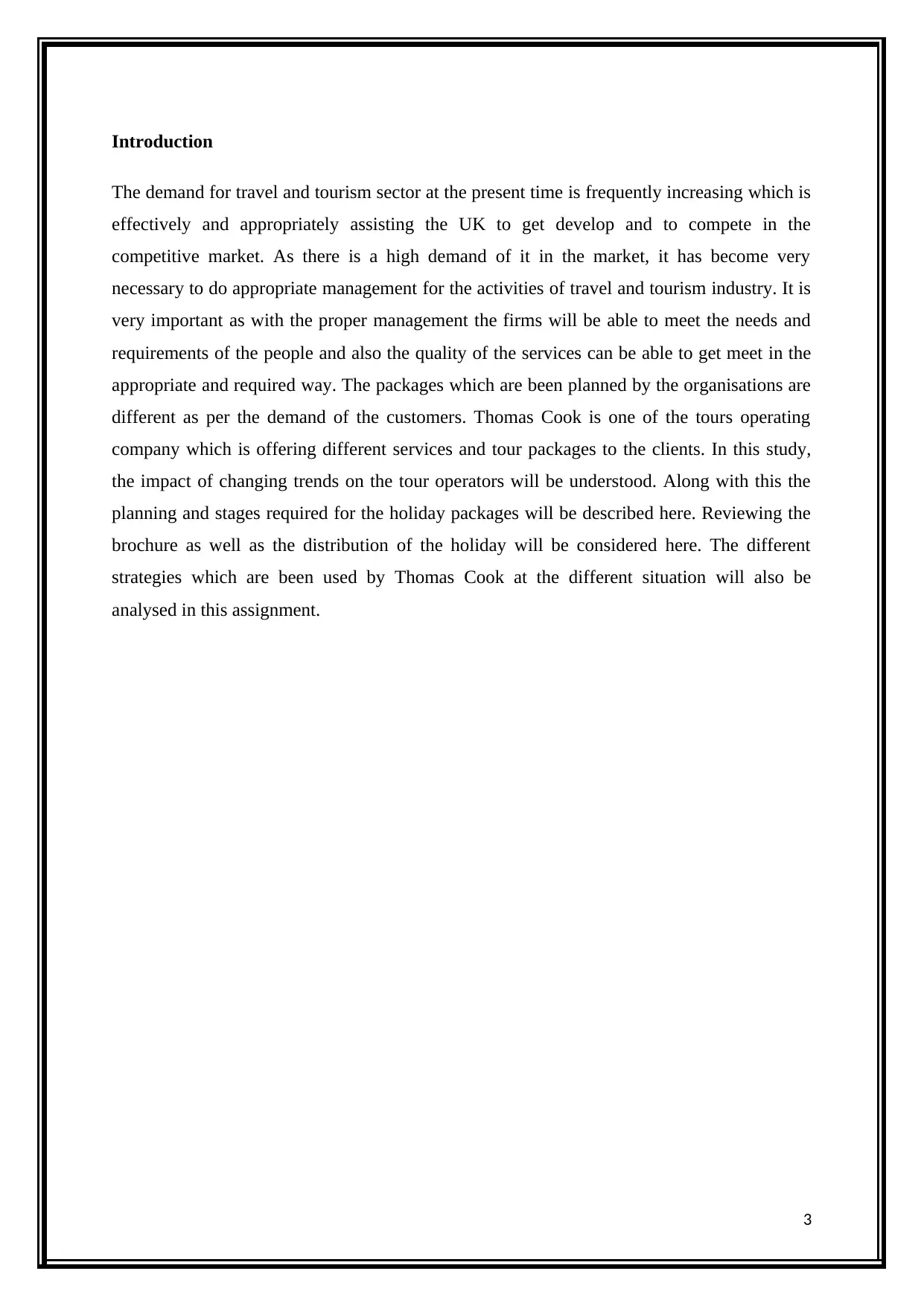
Introduction
The demand for travel and tourism sector at the present time is frequently increasing which is
effectively and appropriately assisting the UK to get develop and to compete in the
competitive market. As there is a high demand of it in the market, it has become very
necessary to do appropriate management for the activities of travel and tourism industry. It is
very important as with the proper management the firms will be able to meet the needs and
requirements of the people and also the quality of the services can be able to get meet in the
appropriate and required way. The packages which are been planned by the organisations are
different as per the demand of the customers. Thomas Cook is one of the tours operating
company which is offering different services and tour packages to the clients. In this study,
the impact of changing trends on the tour operators will be understood. Along with this the
planning and stages required for the holiday packages will be described here. Reviewing the
brochure as well as the distribution of the holiday will be considered here. The different
strategies which are been used by Thomas Cook at the different situation will also be
analysed in this assignment.
3
The demand for travel and tourism sector at the present time is frequently increasing which is
effectively and appropriately assisting the UK to get develop and to compete in the
competitive market. As there is a high demand of it in the market, it has become very
necessary to do appropriate management for the activities of travel and tourism industry. It is
very important as with the proper management the firms will be able to meet the needs and
requirements of the people and also the quality of the services can be able to get meet in the
appropriate and required way. The packages which are been planned by the organisations are
different as per the demand of the customers. Thomas Cook is one of the tours operating
company which is offering different services and tour packages to the clients. In this study,
the impact of changing trends on the tour operators will be understood. Along with this the
planning and stages required for the holiday packages will be described here. Reviewing the
brochure as well as the distribution of the holiday will be considered here. The different
strategies which are been used by Thomas Cook at the different situation will also be
analysed in this assignment.
3
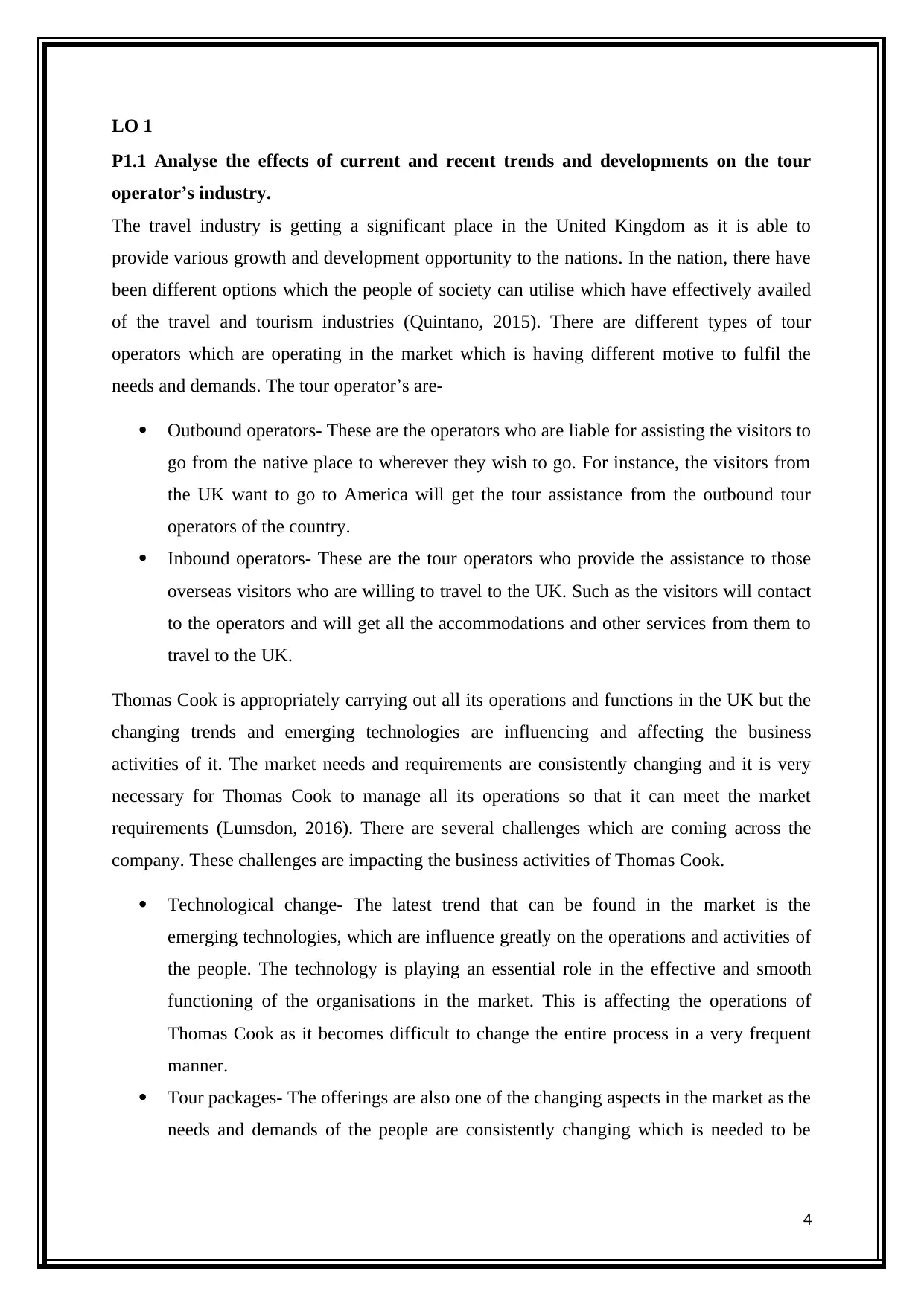
LO 1
P1.1 Analyse the effects of current and recent trends and developments on the tour
operator’s industry.
The travel industry is getting a significant place in the United Kingdom as it is able to
provide various growth and development opportunity to the nations. In the nation, there have
been different options which the people of society can utilise which have effectively availed
of the travel and tourism industries (Quintano, 2015). There are different types of tour
operators which are operating in the market which is having different motive to fulfil the
needs and demands. The tour operator’s are-
Outbound operators- These are the operators who are liable for assisting the visitors to
go from the native place to wherever they wish to go. For instance, the visitors from
the UK want to go to America will get the tour assistance from the outbound tour
operators of the country.
Inbound operators- These are the tour operators who provide the assistance to those
overseas visitors who are willing to travel to the UK. Such as the visitors will contact
to the operators and will get all the accommodations and other services from them to
travel to the UK.
Thomas Cook is appropriately carrying out all its operations and functions in the UK but the
changing trends and emerging technologies are influencing and affecting the business
activities of it. The market needs and requirements are consistently changing and it is very
necessary for Thomas Cook to manage all its operations so that it can meet the market
requirements (Lumsdon, 2016). There are several challenges which are coming across the
company. These challenges are impacting the business activities of Thomas Cook.
Technological change- The latest trend that can be found in the market is the
emerging technologies, which are influence greatly on the operations and activities of
the people. The technology is playing an essential role in the effective and smooth
functioning of the organisations in the market. This is affecting the operations of
Thomas Cook as it becomes difficult to change the entire process in a very frequent
manner.
Tour packages- The offerings are also one of the changing aspects in the market as the
needs and demands of the people are consistently changing which is needed to be
4
P1.1 Analyse the effects of current and recent trends and developments on the tour
operator’s industry.
The travel industry is getting a significant place in the United Kingdom as it is able to
provide various growth and development opportunity to the nations. In the nation, there have
been different options which the people of society can utilise which have effectively availed
of the travel and tourism industries (Quintano, 2015). There are different types of tour
operators which are operating in the market which is having different motive to fulfil the
needs and demands. The tour operator’s are-
Outbound operators- These are the operators who are liable for assisting the visitors to
go from the native place to wherever they wish to go. For instance, the visitors from
the UK want to go to America will get the tour assistance from the outbound tour
operators of the country.
Inbound operators- These are the tour operators who provide the assistance to those
overseas visitors who are willing to travel to the UK. Such as the visitors will contact
to the operators and will get all the accommodations and other services from them to
travel to the UK.
Thomas Cook is appropriately carrying out all its operations and functions in the UK but the
changing trends and emerging technologies are influencing and affecting the business
activities of it. The market needs and requirements are consistently changing and it is very
necessary for Thomas Cook to manage all its operations so that it can meet the market
requirements (Lumsdon, 2016). There are several challenges which are coming across the
company. These challenges are impacting the business activities of Thomas Cook.
Technological change- The latest trend that can be found in the market is the
emerging technologies, which are influence greatly on the operations and activities of
the people. The technology is playing an essential role in the effective and smooth
functioning of the organisations in the market. This is affecting the operations of
Thomas Cook as it becomes difficult to change the entire process in a very frequent
manner.
Tour packages- The offerings are also one of the changing aspects in the market as the
needs and demands of the people are consistently changing which is needed to be
4
Secure Best Marks with AI Grader
Need help grading? Try our AI Grader for instant feedback on your assignments.

effective and appropriately met by the company. Tour packages also need to be
managed by the company unless this will affect the business operations and functions.
Increased purchase power- The purchasing power of the people in the market is
increasing which is leading to a situation where the demands for more perfect and
more specific packages. Therefore, it becomes a difficult task for the company to re-
plan and make more effective strategies for making the customers satisfied.
There is a great role played by the different trade bodies in the nation as with the help of
these regulatory bodies the travel and tourism companies in the nation can be able to carry
out the work in the systematic and well-structured manner. The ABTA (The travel
association) is the largest travel and tourism association in the United Kingdom. This is
effectively and appropriately taking initiatives and providing assistance to the travel agencies
and operators to make the planning in the effective and demanded way.
5
managed by the company unless this will affect the business operations and functions.
Increased purchase power- The purchasing power of the people in the market is
increasing which is leading to a situation where the demands for more perfect and
more specific packages. Therefore, it becomes a difficult task for the company to re-
plan and make more effective strategies for making the customers satisfied.
There is a great role played by the different trade bodies in the nation as with the help of
these regulatory bodies the travel and tourism companies in the nation can be able to carry
out the work in the systematic and well-structured manner. The ABTA (The travel
association) is the largest travel and tourism association in the United Kingdom. This is
effectively and appropriately taking initiatives and providing assistance to the travel agencies
and operators to make the planning in the effective and demanded way.
5

LO 2
P 2.1 Assess the stages and timescales involved in developing holidays
The development of the holiday packages for the customers' is very effectively and
systematically managed and planned so that the people can be able to attain the best offerings
which will make the clients satisfied. There are several stages which are involved in the
developing of the holidays for the customers as there are minor to the major aspect which
necessarily is introduced in the plan then only the package will be able to get reach to the
clients properly (Jensen, 2014). With the appropriate and effective planning, the organisation
can be able to meet the customer’s needs and can deliver the best and quality services. Below
are the stages which are involved in the planning and developing of the holiday for the 42
students for 5 nights-
Market research- This is one of the most important and essential aspects which are needed
to be considered the most as with the help of this the market needs and requirements can be
determined in the proper and in the appropriate way. For the market research, it may take
about 5 to 10 days. This will help the company to know about the demands and according to
that the planning and design of the packages can be done.
Planning and scheduling of tour-This is the stage where the planning and the setting up of
the tour activities are done where the proper scheduling is done in the required and desired
manner.
Negotiation in prices- The company will help in implementing better and attractive pricing
with the help of negotiations with the agents, and is considered very important as it is done
with the supplies or the agents who are involved for booking the trip. They provide the
information about the best packages that are present at that time for the destinations they are
interested in.
Calculating the Final Price and Overall Cost:-The company will then focus on finalizing
the pricing and selecting the best packages. The pricing of the packages includes summing
up of all costs which include the hospitality industry. It further includes the overnight stay
and providing transport to visit, then it is sold to the consumers or the interested travellers
(Evans, 2015). Therefore, the pricing is the important stage in developing the holidays.
6
P 2.1 Assess the stages and timescales involved in developing holidays
The development of the holiday packages for the customers' is very effectively and
systematically managed and planned so that the people can be able to attain the best offerings
which will make the clients satisfied. There are several stages which are involved in the
developing of the holidays for the customers as there are minor to the major aspect which
necessarily is introduced in the plan then only the package will be able to get reach to the
clients properly (Jensen, 2014). With the appropriate and effective planning, the organisation
can be able to meet the customer’s needs and can deliver the best and quality services. Below
are the stages which are involved in the planning and developing of the holiday for the 42
students for 5 nights-
Market research- This is one of the most important and essential aspects which are needed
to be considered the most as with the help of this the market needs and requirements can be
determined in the proper and in the appropriate way. For the market research, it may take
about 5 to 10 days. This will help the company to know about the demands and according to
that the planning and design of the packages can be done.
Planning and scheduling of tour-This is the stage where the planning and the setting up of
the tour activities are done where the proper scheduling is done in the required and desired
manner.
Negotiation in prices- The company will help in implementing better and attractive pricing
with the help of negotiations with the agents, and is considered very important as it is done
with the supplies or the agents who are involved for booking the trip. They provide the
information about the best packages that are present at that time for the destinations they are
interested in.
Calculating the Final Price and Overall Cost:-The company will then focus on finalizing
the pricing and selecting the best packages. The pricing of the packages includes summing
up of all costs which include the hospitality industry. It further includes the overnight stay
and providing transport to visit, then it is sold to the consumers or the interested travellers
(Evans, 2015). Therefore, the pricing is the important stage in developing the holidays.
6
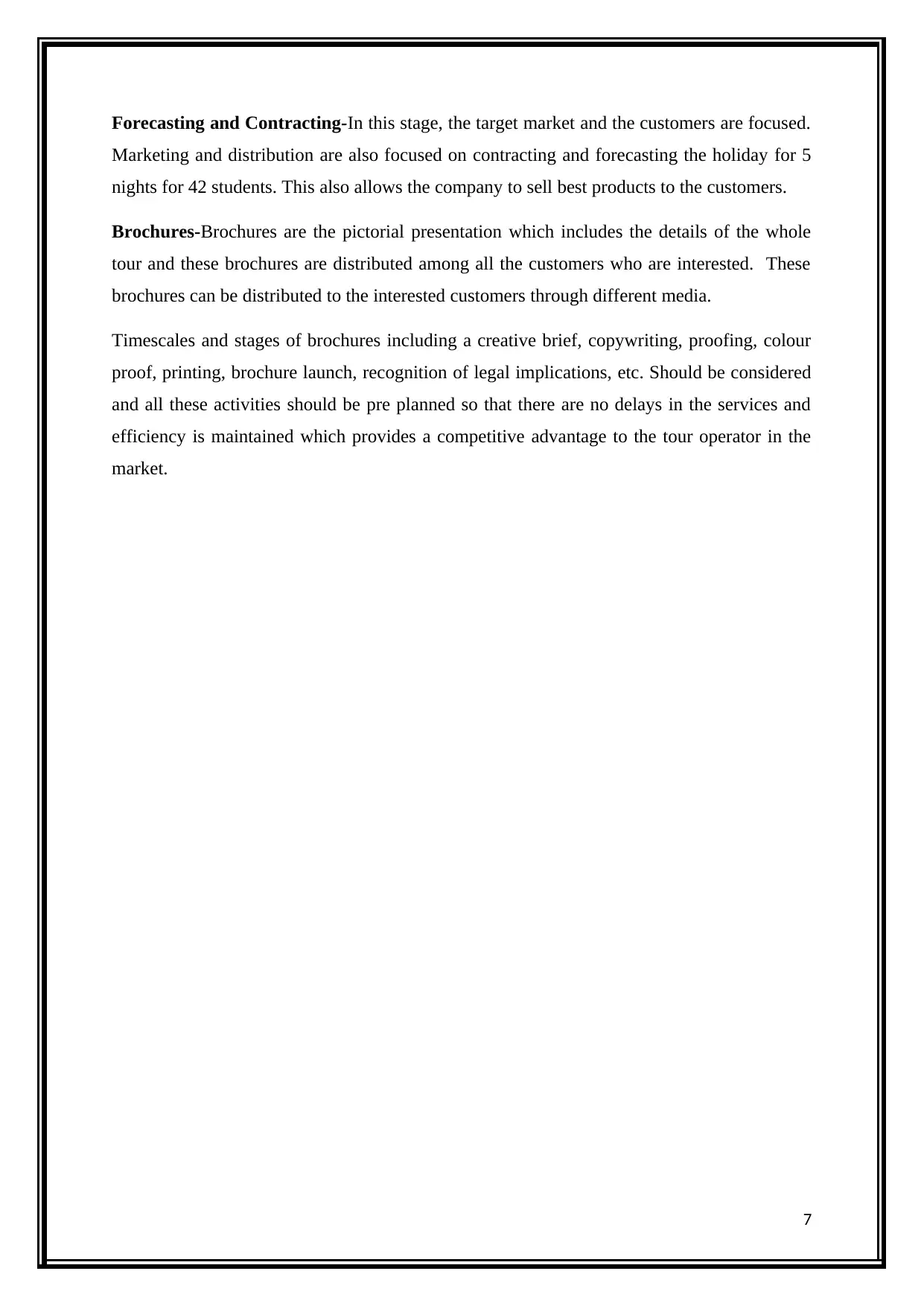
Forecasting and Contracting-In this stage, the target market and the customers are focused.
Marketing and distribution are also focused on contracting and forecasting the holiday for 5
nights for 42 students. This also allows the company to sell best products to the customers.
Brochures-Brochures are the pictorial presentation which includes the details of the whole
tour and these brochures are distributed among all the customers who are interested. These
brochures can be distributed to the interested customers through different media.
Timescales and stages of brochures including a creative brief, copywriting, proofing, colour
proof, printing, brochure launch, recognition of legal implications, etc. Should be considered
and all these activities should be pre planned so that there are no delays in the services and
efficiency is maintained which provides a competitive advantage to the tour operator in the
market.
7
Marketing and distribution are also focused on contracting and forecasting the holiday for 5
nights for 42 students. This also allows the company to sell best products to the customers.
Brochures-Brochures are the pictorial presentation which includes the details of the whole
tour and these brochures are distributed among all the customers who are interested. These
brochures can be distributed to the interested customers through different media.
Timescales and stages of brochures including a creative brief, copywriting, proofing, colour
proof, printing, brochure launch, recognition of legal implications, etc. Should be considered
and all these activities should be pre planned so that there are no delays in the services and
efficiency is maintained which provides a competitive advantage to the tour operator in the
market.
7
Paraphrase This Document
Need a fresh take? Get an instant paraphrase of this document with our AI Paraphraser
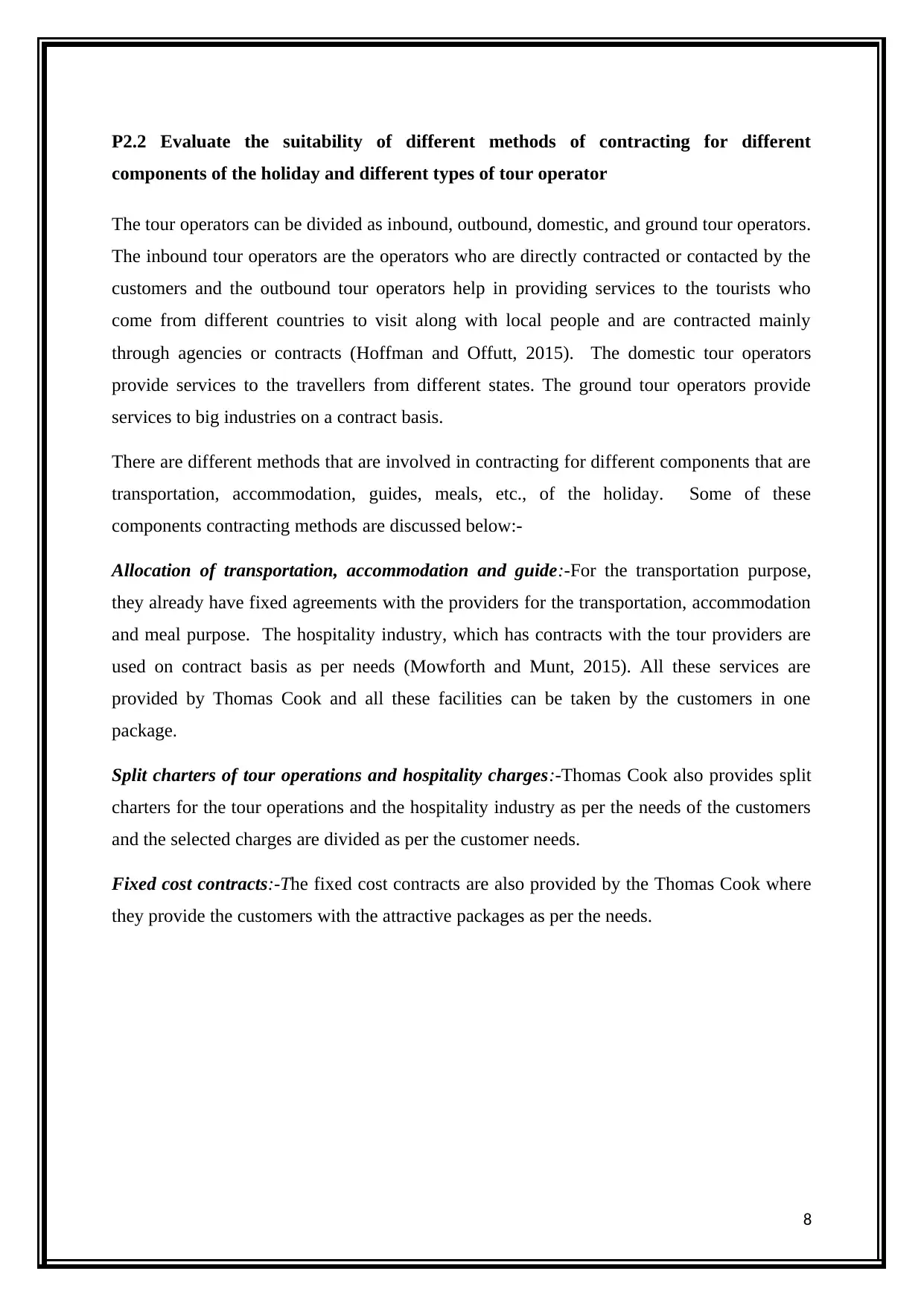
P2.2 Evaluate the suitability of different methods of contracting for different
components of the holiday and different types of tour operator
The tour operators can be divided as inbound, outbound, domestic, and ground tour operators.
The inbound tour operators are the operators who are directly contracted or contacted by the
customers and the outbound tour operators help in providing services to the tourists who
come from different countries to visit along with local people and are contracted mainly
through agencies or contracts (Hoffman and Offutt, 2015). The domestic tour operators
provide services to the travellers from different states. The ground tour operators provide
services to big industries on a contract basis.
There are different methods that are involved in contracting for different components that are
transportation, accommodation, guides, meals, etc., of the holiday. Some of these
components contracting methods are discussed below:-
Allocation of transportation, accommodation and guide:-For the transportation purpose,
they already have fixed agreements with the providers for the transportation, accommodation
and meal purpose. The hospitality industry, which has contracts with the tour providers are
used on contract basis as per needs (Mowforth and Munt, 2015). All these services are
provided by Thomas Cook and all these facilities can be taken by the customers in one
package.
Split charters of tour operations and hospitality charges:-Thomas Cook also provides split
charters for the tour operations and the hospitality industry as per the needs of the customers
and the selected charges are divided as per the customer needs.
Fixed cost contracts:-The fixed cost contracts are also provided by the Thomas Cook where
they provide the customers with the attractive packages as per the needs.
8
components of the holiday and different types of tour operator
The tour operators can be divided as inbound, outbound, domestic, and ground tour operators.
The inbound tour operators are the operators who are directly contracted or contacted by the
customers and the outbound tour operators help in providing services to the tourists who
come from different countries to visit along with local people and are contracted mainly
through agencies or contracts (Hoffman and Offutt, 2015). The domestic tour operators
provide services to the travellers from different states. The ground tour operators provide
services to big industries on a contract basis.
There are different methods that are involved in contracting for different components that are
transportation, accommodation, guides, meals, etc., of the holiday. Some of these
components contracting methods are discussed below:-
Allocation of transportation, accommodation and guide:-For the transportation purpose,
they already have fixed agreements with the providers for the transportation, accommodation
and meal purpose. The hospitality industry, which has contracts with the tour providers are
used on contract basis as per needs (Mowforth and Munt, 2015). All these services are
provided by Thomas Cook and all these facilities can be taken by the customers in one
package.
Split charters of tour operations and hospitality charges:-Thomas Cook also provides split
charters for the tour operations and the hospitality industry as per the needs of the customers
and the selected charges are divided as per the customer needs.
Fixed cost contracts:-The fixed cost contracts are also provided by the Thomas Cook where
they provide the customers with the attractive packages as per the needs.
8
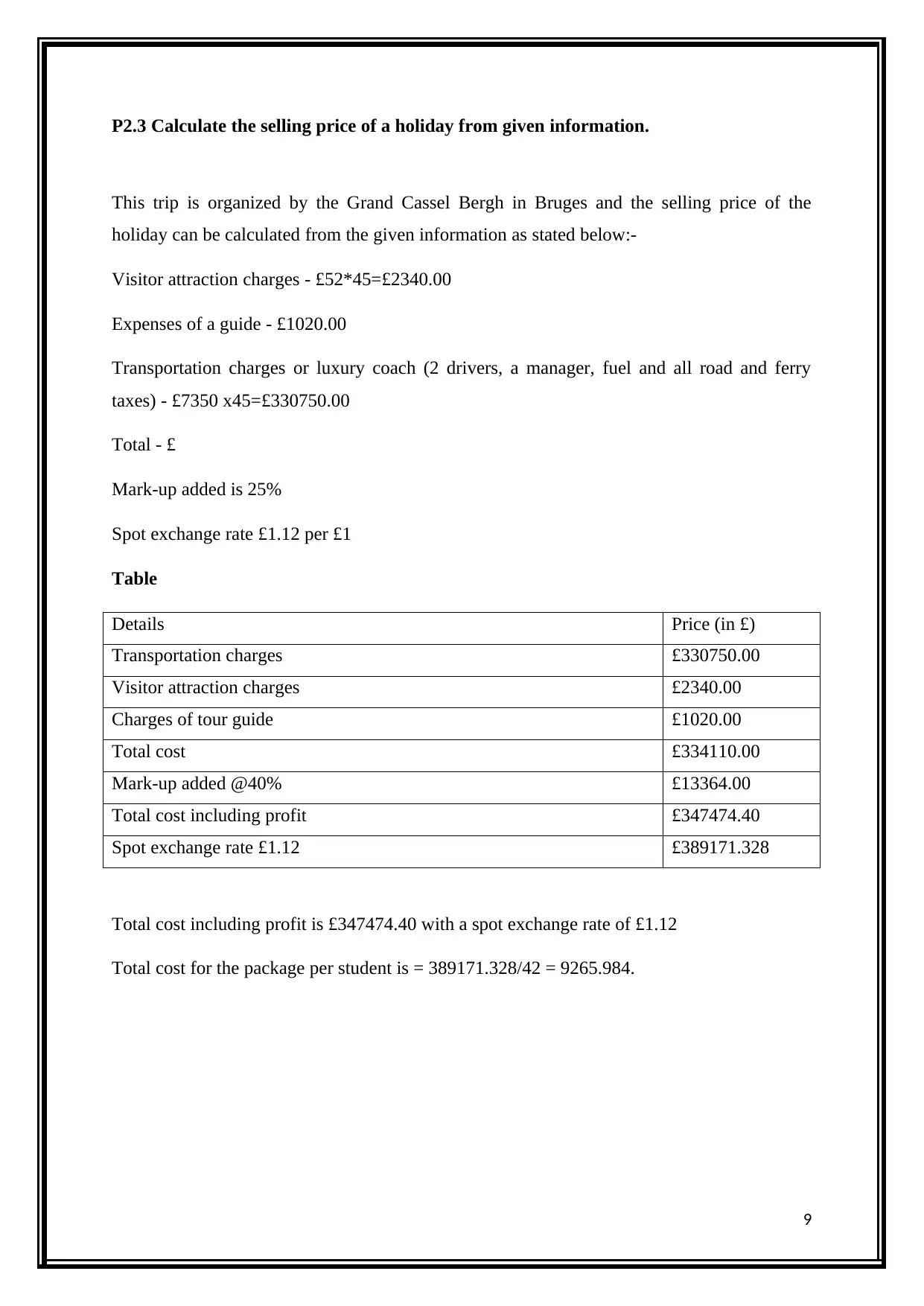
P2.3 Calculate the selling price of a holiday from given information.
This trip is organized by the Grand Cassel Bergh in Bruges and the selling price of the
holiday can be calculated from the given information as stated below:-
Visitor attraction charges - £52*45=£2340.00
Expenses of a guide - £1020.00
Transportation charges or luxury coach (2 drivers, a manager, fuel and all road and ferry
taxes) - £7350 x45=£330750.00
Total - £
Mark-up added is 25%
Spot exchange rate £1.12 per £1
Table
Details Price (in £)
Transportation charges £330750.00
Visitor attraction charges £2340.00
Charges of tour guide £1020.00
Total cost £334110.00
Mark-up added @40% £13364.00
Total cost including profit £347474.40
Spot exchange rate £1.12 £389171.328
Total cost including profit is £347474.40 with a spot exchange rate of £1.12
Total cost for the package per student is = 389171.328/42 = 9265.984.
9
This trip is organized by the Grand Cassel Bergh in Bruges and the selling price of the
holiday can be calculated from the given information as stated below:-
Visitor attraction charges - £52*45=£2340.00
Expenses of a guide - £1020.00
Transportation charges or luxury coach (2 drivers, a manager, fuel and all road and ferry
taxes) - £7350 x45=£330750.00
Total - £
Mark-up added is 25%
Spot exchange rate £1.12 per £1
Table
Details Price (in £)
Transportation charges £330750.00
Visitor attraction charges £2340.00
Charges of tour guide £1020.00
Total cost £334110.00
Mark-up added @40% £13364.00
Total cost including profit £347474.40
Spot exchange rate £1.12 £389171.328
Total cost including profit is £347474.40 with a spot exchange rate of £1.12
Total cost for the package per student is = 389171.328/42 = 9265.984.
9
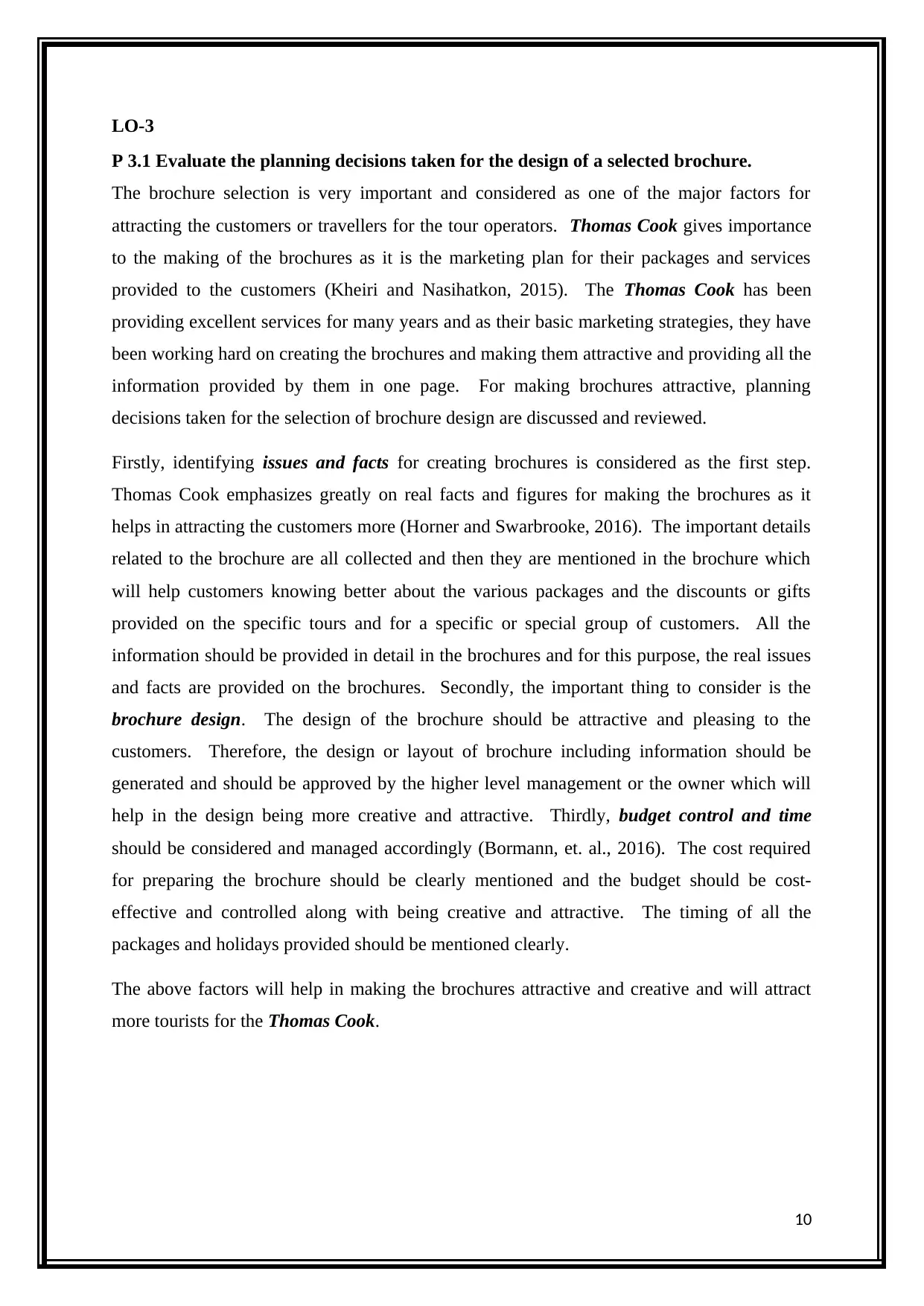
LO-3
P 3.1 Evaluate the planning decisions taken for the design of a selected brochure.
The brochure selection is very important and considered as one of the major factors for
attracting the customers or travellers for the tour operators. Thomas Cook gives importance
to the making of the brochures as it is the marketing plan for their packages and services
provided to the customers (Kheiri and Nasihatkon, 2015). The Thomas Cook has been
providing excellent services for many years and as their basic marketing strategies, they have
been working hard on creating the brochures and making them attractive and providing all the
information provided by them in one page. For making brochures attractive, planning
decisions taken for the selection of brochure design are discussed and reviewed.
Firstly, identifying issues and facts for creating brochures is considered as the first step.
Thomas Cook emphasizes greatly on real facts and figures for making the brochures as it
helps in attracting the customers more (Horner and Swarbrooke, 2016). The important details
related to the brochure are all collected and then they are mentioned in the brochure which
will help customers knowing better about the various packages and the discounts or gifts
provided on the specific tours and for a specific or special group of customers. All the
information should be provided in detail in the brochures and for this purpose, the real issues
and facts are provided on the brochures. Secondly, the important thing to consider is the
brochure design. The design of the brochure should be attractive and pleasing to the
customers. Therefore, the design or layout of brochure including information should be
generated and should be approved by the higher level management or the owner which will
help in the design being more creative and attractive. Thirdly, budget control and time
should be considered and managed accordingly (Bormann, et. al., 2016). The cost required
for preparing the brochure should be clearly mentioned and the budget should be cost-
effective and controlled along with being creative and attractive. The timing of all the
packages and holidays provided should be mentioned clearly.
The above factors will help in making the brochures attractive and creative and will attract
more tourists for the Thomas Cook.
10
P 3.1 Evaluate the planning decisions taken for the design of a selected brochure.
The brochure selection is very important and considered as one of the major factors for
attracting the customers or travellers for the tour operators. Thomas Cook gives importance
to the making of the brochures as it is the marketing plan for their packages and services
provided to the customers (Kheiri and Nasihatkon, 2015). The Thomas Cook has been
providing excellent services for many years and as their basic marketing strategies, they have
been working hard on creating the brochures and making them attractive and providing all the
information provided by them in one page. For making brochures attractive, planning
decisions taken for the selection of brochure design are discussed and reviewed.
Firstly, identifying issues and facts for creating brochures is considered as the first step.
Thomas Cook emphasizes greatly on real facts and figures for making the brochures as it
helps in attracting the customers more (Horner and Swarbrooke, 2016). The important details
related to the brochure are all collected and then they are mentioned in the brochure which
will help customers knowing better about the various packages and the discounts or gifts
provided on the specific tours and for a specific or special group of customers. All the
information should be provided in detail in the brochures and for this purpose, the real issues
and facts are provided on the brochures. Secondly, the important thing to consider is the
brochure design. The design of the brochure should be attractive and pleasing to the
customers. Therefore, the design or layout of brochure including information should be
generated and should be approved by the higher level management or the owner which will
help in the design being more creative and attractive. Thirdly, budget control and time
should be considered and managed accordingly (Bormann, et. al., 2016). The cost required
for preparing the brochure should be clearly mentioned and the budget should be cost-
effective and controlled along with being creative and attractive. The timing of all the
packages and holidays provided should be mentioned clearly.
The above factors will help in making the brochures attractive and creative and will attract
more tourists for the Thomas Cook.
10
Secure Best Marks with AI Grader
Need help grading? Try our AI Grader for instant feedback on your assignments.
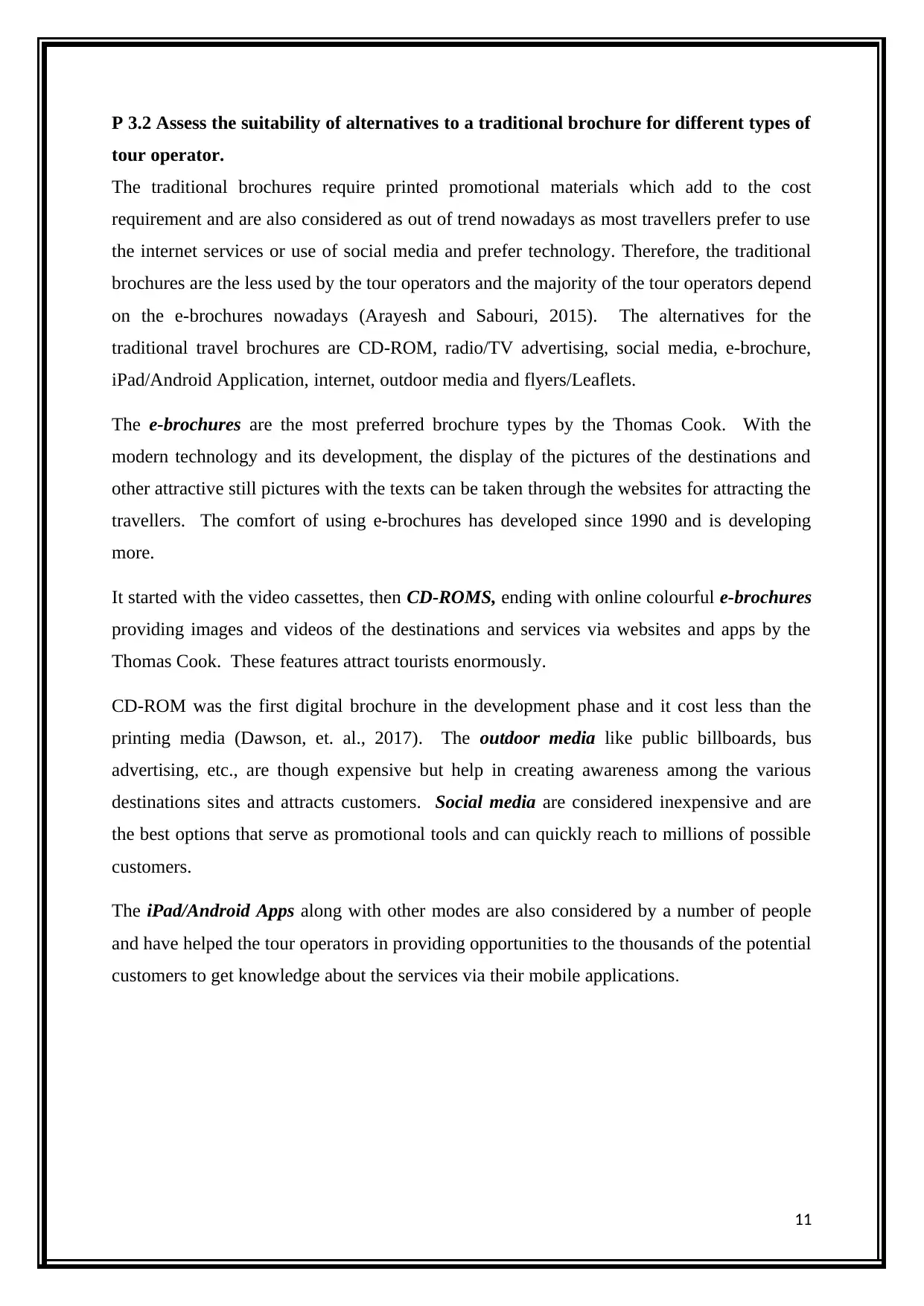
P 3.2 Assess the suitability of alternatives to a traditional brochure for different types of
tour operator.
The traditional brochures require printed promotional materials which add to the cost
requirement and are also considered as out of trend nowadays as most travellers prefer to use
the internet services or use of social media and prefer technology. Therefore, the traditional
brochures are the less used by the tour operators and the majority of the tour operators depend
on the e-brochures nowadays (Arayesh and Sabouri, 2015). The alternatives for the
traditional travel brochures are CD-ROM, radio/TV advertising, social media, e-brochure,
iPad/Android Application, internet, outdoor media and flyers/Leaflets.
The e-brochures are the most preferred brochure types by the Thomas Cook. With the
modern technology and its development, the display of the pictures of the destinations and
other attractive still pictures with the texts can be taken through the websites for attracting the
travellers. The comfort of using e-brochures has developed since 1990 and is developing
more.
It started with the video cassettes, then CD-ROMS, ending with online colourful e-brochures
providing images and videos of the destinations and services via websites and apps by the
Thomas Cook. These features attract tourists enormously.
CD-ROM was the first digital brochure in the development phase and it cost less than the
printing media (Dawson, et. al., 2017). The outdoor media like public billboards, bus
advertising, etc., are though expensive but help in creating awareness among the various
destinations sites and attracts customers. Social media are considered inexpensive and are
the best options that serve as promotional tools and can quickly reach to millions of possible
customers.
The iPad/Android Apps along with other modes are also considered by a number of people
and have helped the tour operators in providing opportunities to the thousands of the potential
customers to get knowledge about the services via their mobile applications.
11
tour operator.
The traditional brochures require printed promotional materials which add to the cost
requirement and are also considered as out of trend nowadays as most travellers prefer to use
the internet services or use of social media and prefer technology. Therefore, the traditional
brochures are the less used by the tour operators and the majority of the tour operators depend
on the e-brochures nowadays (Arayesh and Sabouri, 2015). The alternatives for the
traditional travel brochures are CD-ROM, radio/TV advertising, social media, e-brochure,
iPad/Android Application, internet, outdoor media and flyers/Leaflets.
The e-brochures are the most preferred brochure types by the Thomas Cook. With the
modern technology and its development, the display of the pictures of the destinations and
other attractive still pictures with the texts can be taken through the websites for attracting the
travellers. The comfort of using e-brochures has developed since 1990 and is developing
more.
It started with the video cassettes, then CD-ROMS, ending with online colourful e-brochures
providing images and videos of the destinations and services via websites and apps by the
Thomas Cook. These features attract tourists enormously.
CD-ROM was the first digital brochure in the development phase and it cost less than the
printing media (Dawson, et. al., 2017). The outdoor media like public billboards, bus
advertising, etc., are though expensive but help in creating awareness among the various
destinations sites and attracts customers. Social media are considered inexpensive and are
the best options that serve as promotional tools and can quickly reach to millions of possible
customers.
The iPad/Android Apps along with other modes are also considered by a number of people
and have helped the tour operators in providing opportunities to the thousands of the potential
customers to get knowledge about the services via their mobile applications.
11
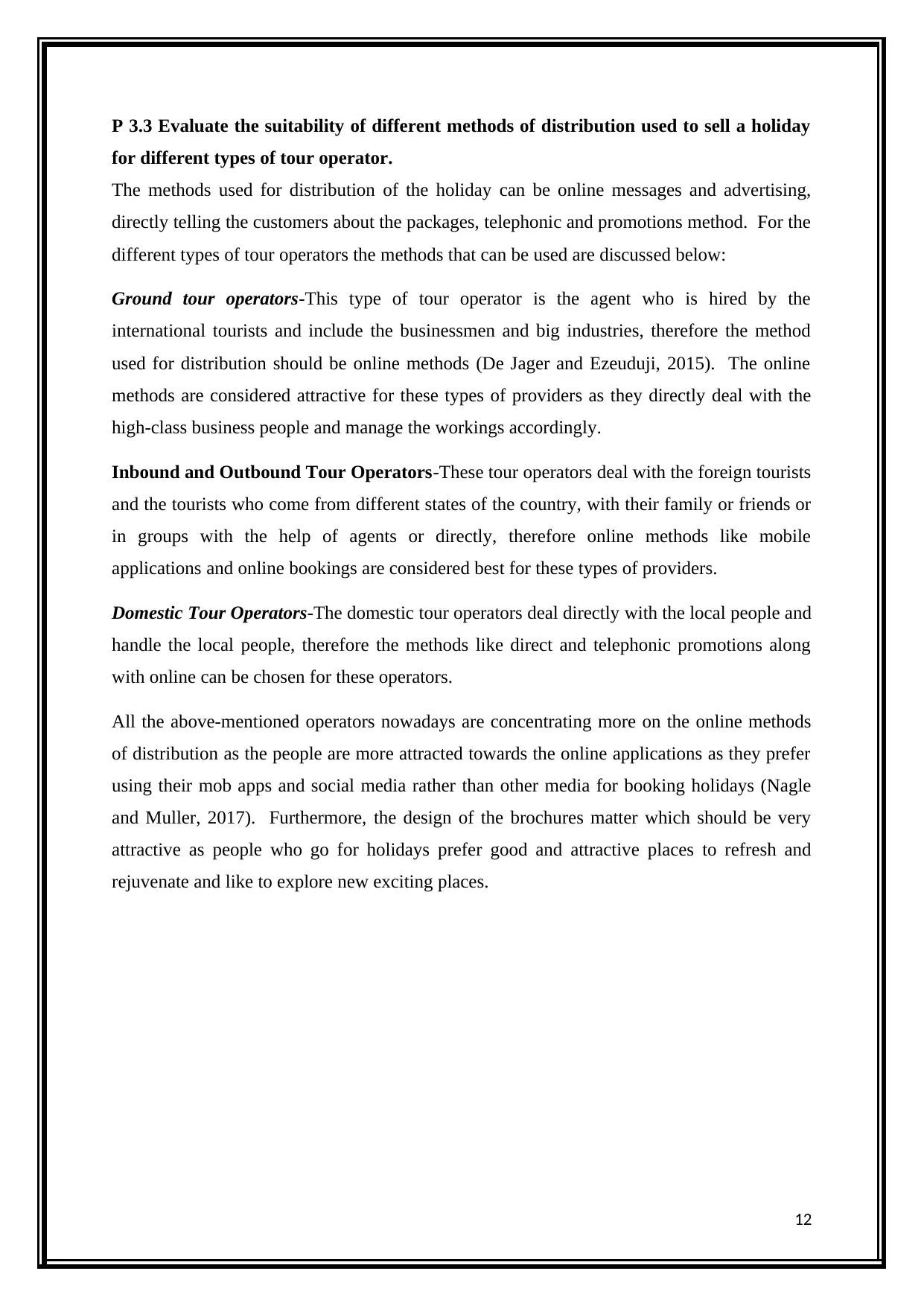
P 3.3 Evaluate the suitability of different methods of distribution used to sell a holiday
for different types of tour operator.
The methods used for distribution of the holiday can be online messages and advertising,
directly telling the customers about the packages, telephonic and promotions method. For the
different types of tour operators the methods that can be used are discussed below:
Ground tour operators-This type of tour operator is the agent who is hired by the
international tourists and include the businessmen and big industries, therefore the method
used for distribution should be online methods (De Jager and Ezeuduji, 2015). The online
methods are considered attractive for these types of providers as they directly deal with the
high-class business people and manage the workings accordingly.
Inbound and Outbound Tour Operators-These tour operators deal with the foreign tourists
and the tourists who come from different states of the country, with their family or friends or
in groups with the help of agents or directly, therefore online methods like mobile
applications and online bookings are considered best for these types of providers.
Domestic Tour Operators-The domestic tour operators deal directly with the local people and
handle the local people, therefore the methods like direct and telephonic promotions along
with online can be chosen for these operators.
All the above-mentioned operators nowadays are concentrating more on the online methods
of distribution as the people are more attracted towards the online applications as they prefer
using their mob apps and social media rather than other media for booking holidays (Nagle
and Muller, 2017). Furthermore, the design of the brochures matter which should be very
attractive as people who go for holidays prefer good and attractive places to refresh and
rejuvenate and like to explore new exciting places.
12
for different types of tour operator.
The methods used for distribution of the holiday can be online messages and advertising,
directly telling the customers about the packages, telephonic and promotions method. For the
different types of tour operators the methods that can be used are discussed below:
Ground tour operators-This type of tour operator is the agent who is hired by the
international tourists and include the businessmen and big industries, therefore the method
used for distribution should be online methods (De Jager and Ezeuduji, 2015). The online
methods are considered attractive for these types of providers as they directly deal with the
high-class business people and manage the workings accordingly.
Inbound and Outbound Tour Operators-These tour operators deal with the foreign tourists
and the tourists who come from different states of the country, with their family or friends or
in groups with the help of agents or directly, therefore online methods like mobile
applications and online bookings are considered best for these types of providers.
Domestic Tour Operators-The domestic tour operators deal directly with the local people and
handle the local people, therefore the methods like direct and telephonic promotions along
with online can be chosen for these operators.
All the above-mentioned operators nowadays are concentrating more on the online methods
of distribution as the people are more attracted towards the online applications as they prefer
using their mob apps and social media rather than other media for booking holidays (Nagle
and Muller, 2017). Furthermore, the design of the brochures matter which should be very
attractive as people who go for holidays prefer good and attractive places to refresh and
rejuvenate and like to explore new exciting places.
12
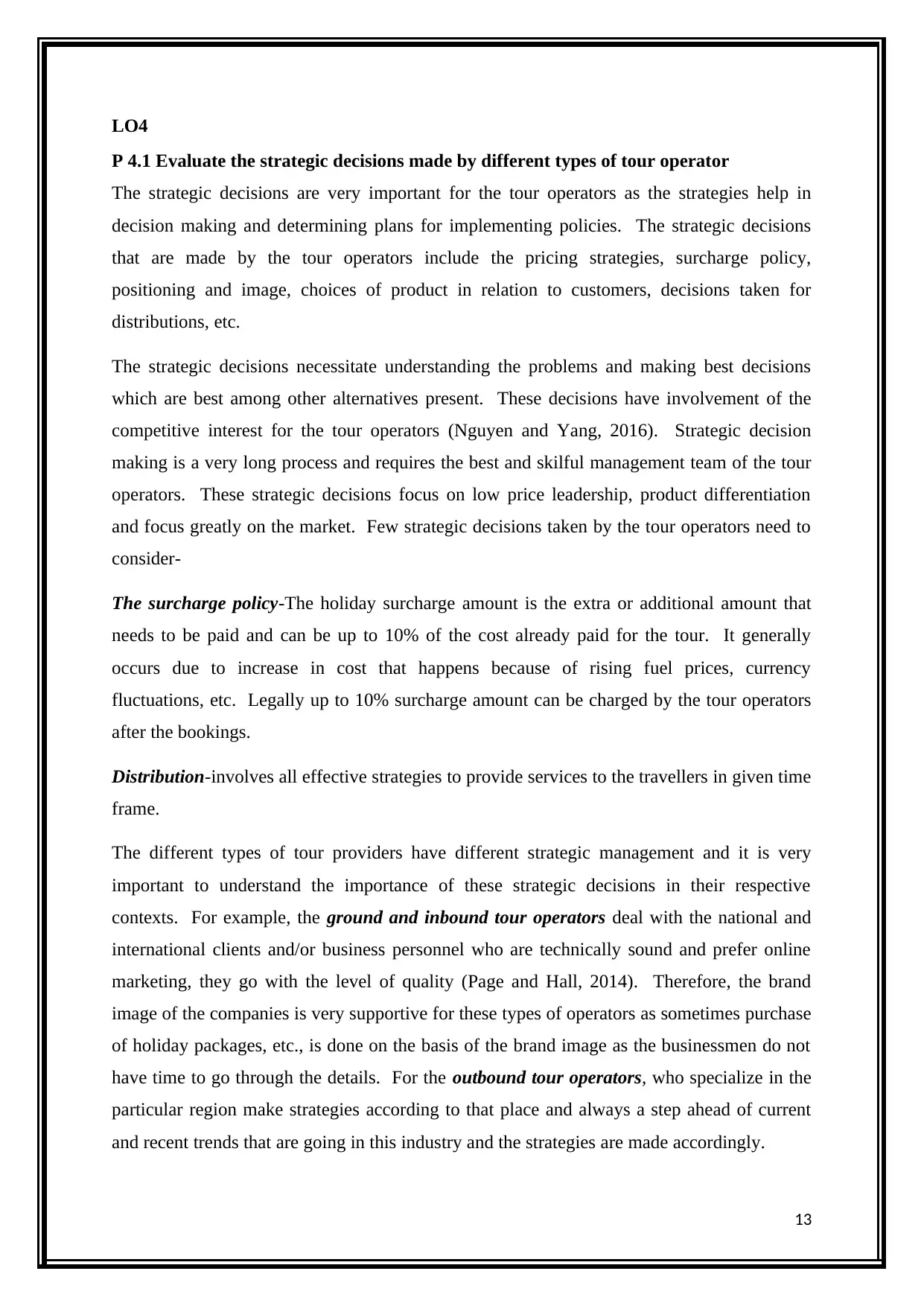
LO4
P 4.1 Evaluate the strategic decisions made by different types of tour operator
The strategic decisions are very important for the tour operators as the strategies help in
decision making and determining plans for implementing policies. The strategic decisions
that are made by the tour operators include the pricing strategies, surcharge policy,
positioning and image, choices of product in relation to customers, decisions taken for
distributions, etc.
The strategic decisions necessitate understanding the problems and making best decisions
which are best among other alternatives present. These decisions have involvement of the
competitive interest for the tour operators (Nguyen and Yang, 2016). Strategic decision
making is a very long process and requires the best and skilful management team of the tour
operators. These strategic decisions focus on low price leadership, product differentiation
and focus greatly on the market. Few strategic decisions taken by the tour operators need to
consider-
The surcharge policy-The holiday surcharge amount is the extra or additional amount that
needs to be paid and can be up to 10% of the cost already paid for the tour. It generally
occurs due to increase in cost that happens because of rising fuel prices, currency
fluctuations, etc. Legally up to 10% surcharge amount can be charged by the tour operators
after the bookings.
Distribution-involves all effective strategies to provide services to the travellers in given time
frame.
The different types of tour providers have different strategic management and it is very
important to understand the importance of these strategic decisions in their respective
contexts. For example, the ground and inbound tour operators deal with the national and
international clients and/or business personnel who are technically sound and prefer online
marketing, they go with the level of quality (Page and Hall, 2014). Therefore, the brand
image of the companies is very supportive for these types of operators as sometimes purchase
of holiday packages, etc., is done on the basis of the brand image as the businessmen do not
have time to go through the details. For the outbound tour operators, who specialize in the
particular region make strategies according to that place and always a step ahead of current
and recent trends that are going in this industry and the strategies are made accordingly.
13
P 4.1 Evaluate the strategic decisions made by different types of tour operator
The strategic decisions are very important for the tour operators as the strategies help in
decision making and determining plans for implementing policies. The strategic decisions
that are made by the tour operators include the pricing strategies, surcharge policy,
positioning and image, choices of product in relation to customers, decisions taken for
distributions, etc.
The strategic decisions necessitate understanding the problems and making best decisions
which are best among other alternatives present. These decisions have involvement of the
competitive interest for the tour operators (Nguyen and Yang, 2016). Strategic decision
making is a very long process and requires the best and skilful management team of the tour
operators. These strategic decisions focus on low price leadership, product differentiation
and focus greatly on the market. Few strategic decisions taken by the tour operators need to
consider-
The surcharge policy-The holiday surcharge amount is the extra or additional amount that
needs to be paid and can be up to 10% of the cost already paid for the tour. It generally
occurs due to increase in cost that happens because of rising fuel prices, currency
fluctuations, etc. Legally up to 10% surcharge amount can be charged by the tour operators
after the bookings.
Distribution-involves all effective strategies to provide services to the travellers in given time
frame.
The different types of tour providers have different strategic management and it is very
important to understand the importance of these strategic decisions in their respective
contexts. For example, the ground and inbound tour operators deal with the national and
international clients and/or business personnel who are technically sound and prefer online
marketing, they go with the level of quality (Page and Hall, 2014). Therefore, the brand
image of the companies is very supportive for these types of operators as sometimes purchase
of holiday packages, etc., is done on the basis of the brand image as the businessmen do not
have time to go through the details. For the outbound tour operators, who specialize in the
particular region make strategies according to that place and always a step ahead of current
and recent trends that are going in this industry and the strategies are made accordingly.
13
Paraphrase This Document
Need a fresh take? Get an instant paraphrase of this document with our AI Paraphraser
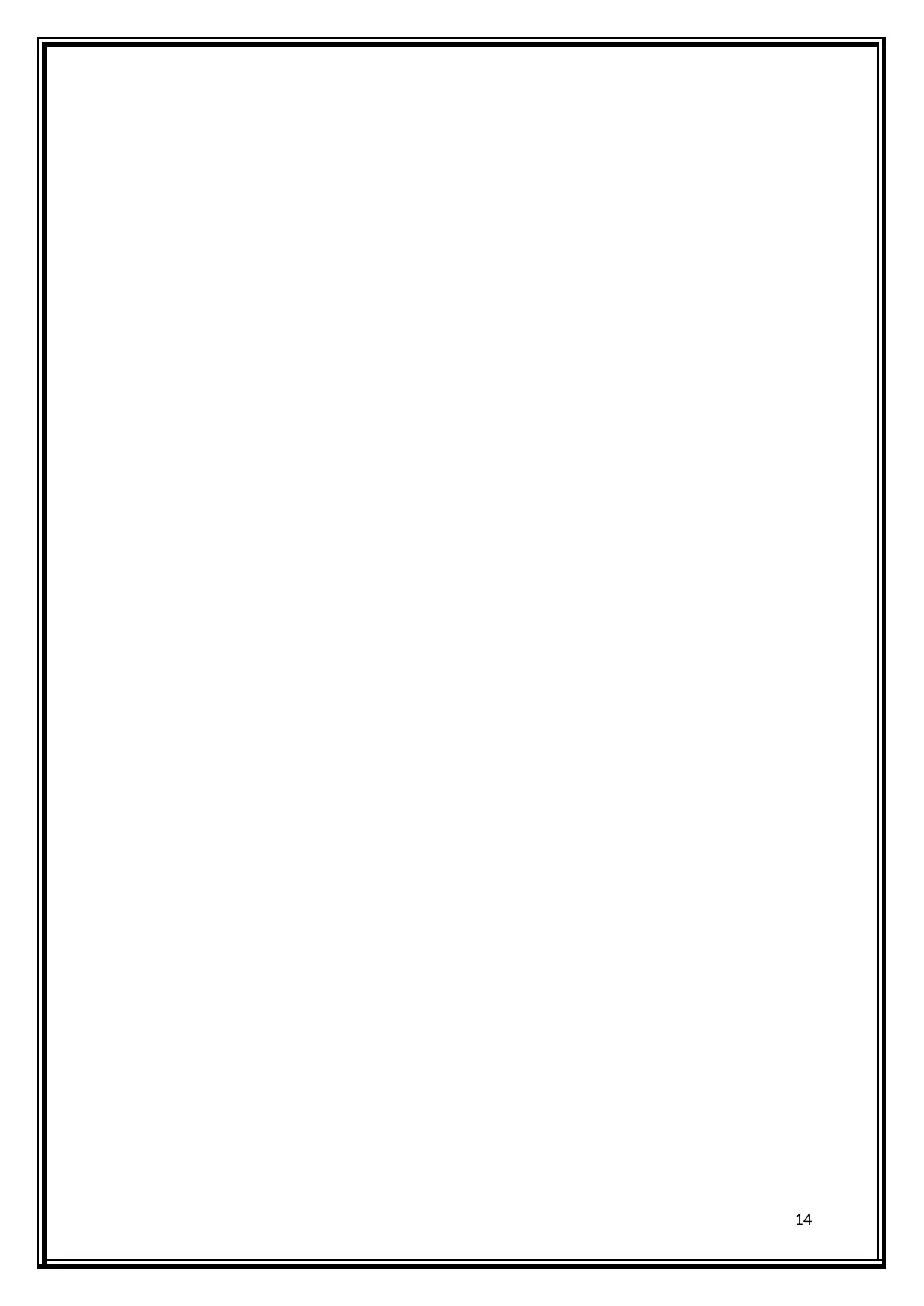
14
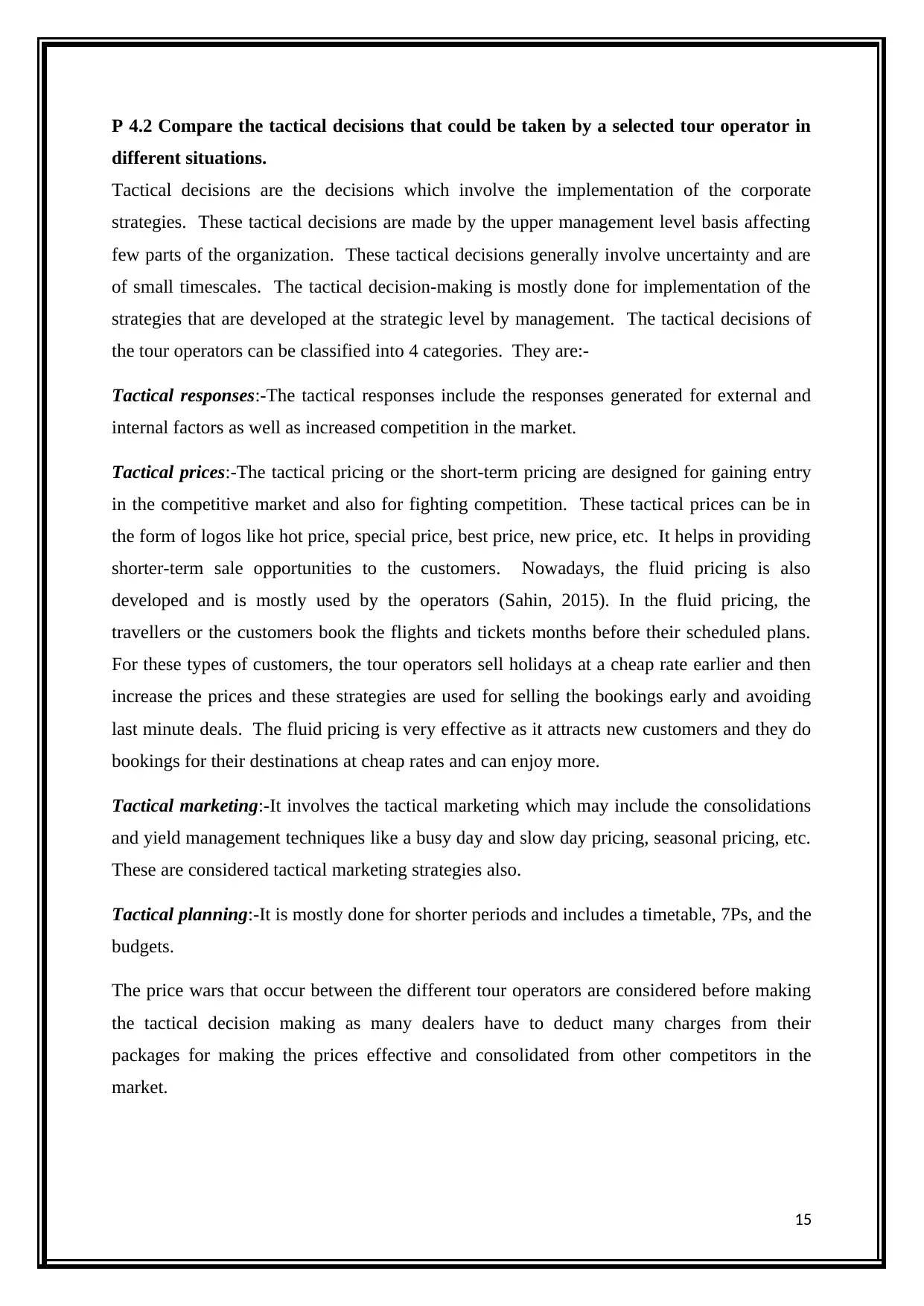
P 4.2 Compare the tactical decisions that could be taken by a selected tour operator in
different situations.
Tactical decisions are the decisions which involve the implementation of the corporate
strategies. These tactical decisions are made by the upper management level basis affecting
few parts of the organization. These tactical decisions generally involve uncertainty and are
of small timescales. The tactical decision-making is mostly done for implementation of the
strategies that are developed at the strategic level by management. The tactical decisions of
the tour operators can be classified into 4 categories. They are:-
Tactical responses:-The tactical responses include the responses generated for external and
internal factors as well as increased competition in the market.
Tactical prices:-The tactical pricing or the short-term pricing are designed for gaining entry
in the competitive market and also for fighting competition. These tactical prices can be in
the form of logos like hot price, special price, best price, new price, etc. It helps in providing
shorter-term sale opportunities to the customers. Nowadays, the fluid pricing is also
developed and is mostly used by the operators (Sahin, 2015). In the fluid pricing, the
travellers or the customers book the flights and tickets months before their scheduled plans.
For these types of customers, the tour operators sell holidays at a cheap rate earlier and then
increase the prices and these strategies are used for selling the bookings early and avoiding
last minute deals. The fluid pricing is very effective as it attracts new customers and they do
bookings for their destinations at cheap rates and can enjoy more.
Tactical marketing:-It involves the tactical marketing which may include the consolidations
and yield management techniques like a busy day and slow day pricing, seasonal pricing, etc.
These are considered tactical marketing strategies also.
Tactical planning:-It is mostly done for shorter periods and includes a timetable, 7Ps, and the
budgets.
The price wars that occur between the different tour operators are considered before making
the tactical decision making as many dealers have to deduct many charges from their
packages for making the prices effective and consolidated from other competitors in the
market.
15
different situations.
Tactical decisions are the decisions which involve the implementation of the corporate
strategies. These tactical decisions are made by the upper management level basis affecting
few parts of the organization. These tactical decisions generally involve uncertainty and are
of small timescales. The tactical decision-making is mostly done for implementation of the
strategies that are developed at the strategic level by management. The tactical decisions of
the tour operators can be classified into 4 categories. They are:-
Tactical responses:-The tactical responses include the responses generated for external and
internal factors as well as increased competition in the market.
Tactical prices:-The tactical pricing or the short-term pricing are designed for gaining entry
in the competitive market and also for fighting competition. These tactical prices can be in
the form of logos like hot price, special price, best price, new price, etc. It helps in providing
shorter-term sale opportunities to the customers. Nowadays, the fluid pricing is also
developed and is mostly used by the operators (Sahin, 2015). In the fluid pricing, the
travellers or the customers book the flights and tickets months before their scheduled plans.
For these types of customers, the tour operators sell holidays at a cheap rate earlier and then
increase the prices and these strategies are used for selling the bookings early and avoiding
last minute deals. The fluid pricing is very effective as it attracts new customers and they do
bookings for their destinations at cheap rates and can enjoy more.
Tactical marketing:-It involves the tactical marketing which may include the consolidations
and yield management techniques like a busy day and slow day pricing, seasonal pricing, etc.
These are considered tactical marketing strategies also.
Tactical planning:-It is mostly done for shorter periods and includes a timetable, 7Ps, and the
budgets.
The price wars that occur between the different tour operators are considered before making
the tactical decision making as many dealers have to deduct many charges from their
packages for making the prices effective and consolidated from other competitors in the
market.
15
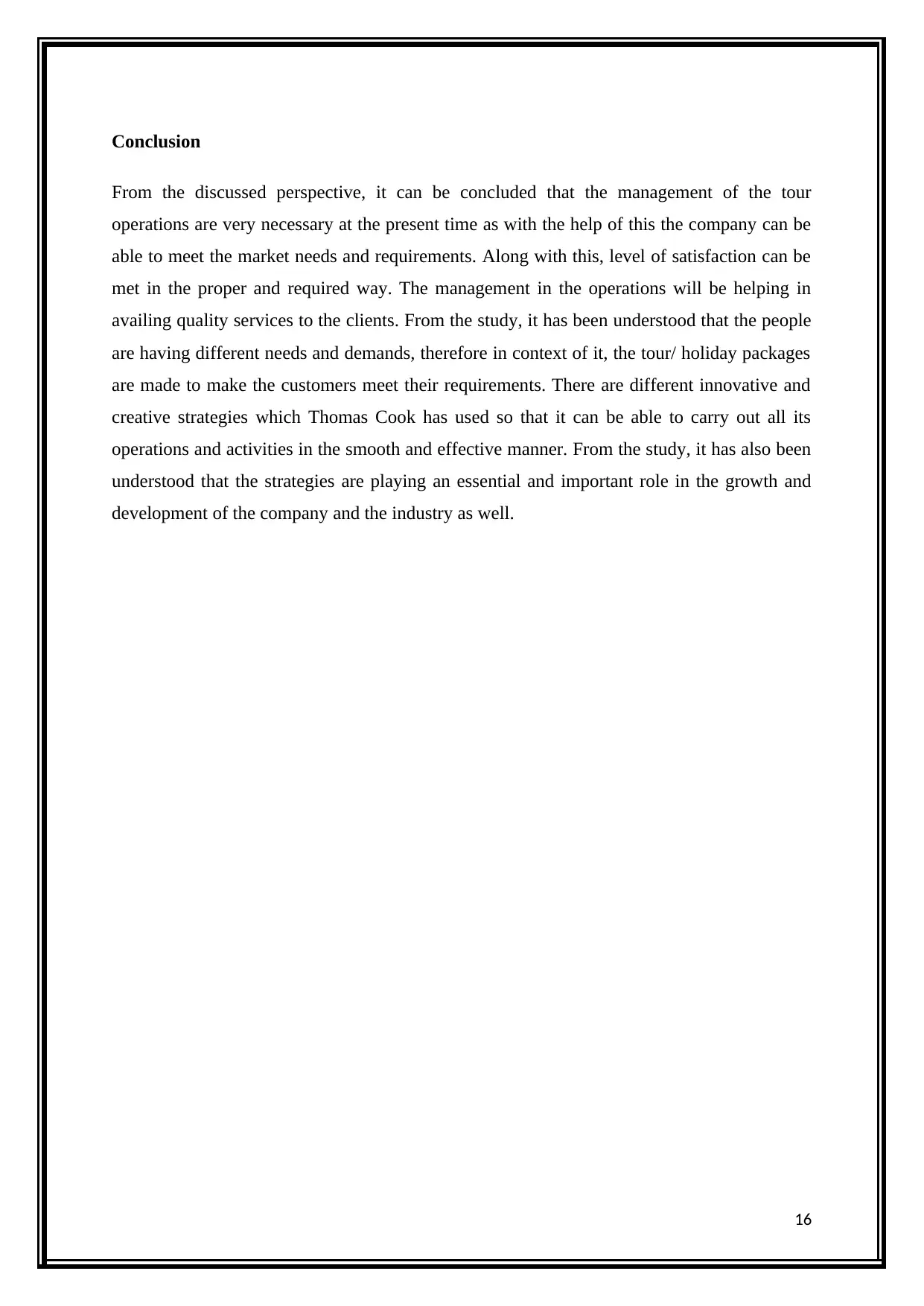
Conclusion
From the discussed perspective, it can be concluded that the management of the tour
operations are very necessary at the present time as with the help of this the company can be
able to meet the market needs and requirements. Along with this, level of satisfaction can be
met in the proper and required way. The management in the operations will be helping in
availing quality services to the clients. From the study, it has been understood that the people
are having different needs and demands, therefore in context of it, the tour/ holiday packages
are made to make the customers meet their requirements. There are different innovative and
creative strategies which Thomas Cook has used so that it can be able to carry out all its
operations and activities in the smooth and effective manner. From the study, it has also been
understood that the strategies are playing an essential and important role in the growth and
development of the company and the industry as well.
16
From the discussed perspective, it can be concluded that the management of the tour
operations are very necessary at the present time as with the help of this the company can be
able to meet the market needs and requirements. Along with this, level of satisfaction can be
met in the proper and required way. The management in the operations will be helping in
availing quality services to the clients. From the study, it has been understood that the people
are having different needs and demands, therefore in context of it, the tour/ holiday packages
are made to make the customers meet their requirements. There are different innovative and
creative strategies which Thomas Cook has used so that it can be able to carry out all its
operations and activities in the smooth and effective manner. From the study, it has also been
understood that the strategies are playing an essential and important role in the growth and
development of the company and the industry as well.
16
Secure Best Marks with AI Grader
Need help grading? Try our AI Grader for instant feedback on your assignments.
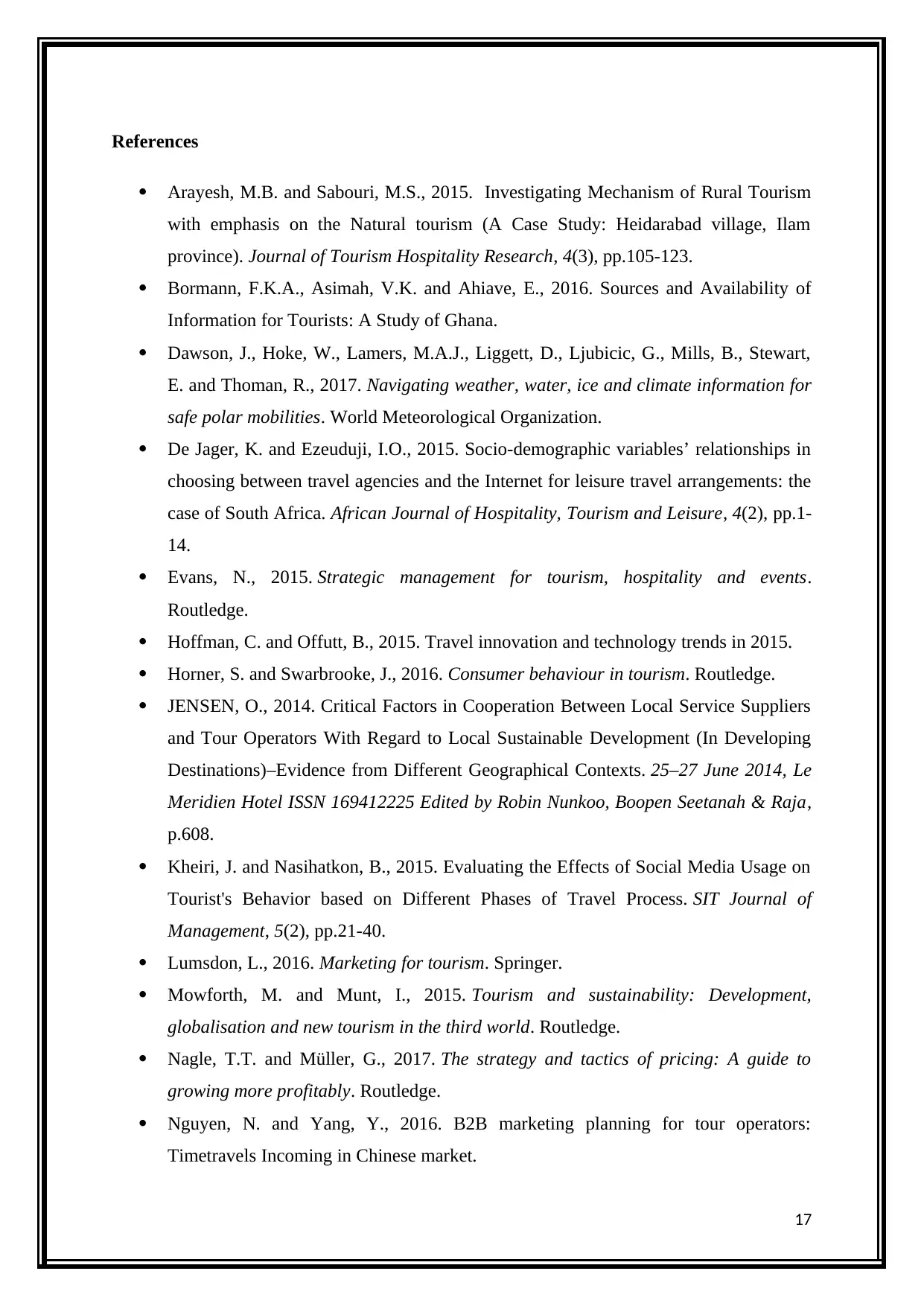
References
Arayesh, M.B. and Sabouri, M.S., 2015. Investigating Mechanism of Rural Tourism
with emphasis on the Natural tourism (A Case Study: Heidarabad village, Ilam
province). Journal of Tourism Hospitality Research, 4(3), pp.105-123.
Bormann, F.K.A., Asimah, V.K. and Ahiave, E., 2016. Sources and Availability of
Information for Tourists: A Study of Ghana.
Dawson, J., Hoke, W., Lamers, M.A.J., Liggett, D., Ljubicic, G., Mills, B., Stewart,
E. and Thoman, R., 2017. Navigating weather, water, ice and climate information for
safe polar mobilities. World Meteorological Organization.
De Jager, K. and Ezeuduji, I.O., 2015. Socio-demographic variables’ relationships in
choosing between travel agencies and the Internet for leisure travel arrangements: the
case of South Africa. African Journal of Hospitality, Tourism and Leisure, 4(2), pp.1-
14.
Evans, N., 2015. Strategic management for tourism, hospitality and events.
Routledge.
Hoffman, C. and Offutt, B., 2015. Travel innovation and technology trends in 2015.
Horner, S. and Swarbrooke, J., 2016. Consumer behaviour in tourism. Routledge.
JENSEN, O., 2014. Critical Factors in Cooperation Between Local Service Suppliers
and Tour Operators With Regard to Local Sustainable Development (In Developing
Destinations)–Evidence from Different Geographical Contexts. 25–27 June 2014, Le
Meridien Hotel ISSN 169412225 Edited by Robin Nunkoo, Boopen Seetanah & Raja,
p.608.
Kheiri, J. and Nasihatkon, B., 2015. Evaluating the Effects of Social Media Usage on
Tourist's Behavior based on Different Phases of Travel Process. SIT Journal of
Management, 5(2), pp.21-40.
Lumsdon, L., 2016. Marketing for tourism. Springer.
Mowforth, M. and Munt, I., 2015. Tourism and sustainability: Development,
globalisation and new tourism in the third world. Routledge.
Nagle, T.T. and Müller, G., 2017. The strategy and tactics of pricing: A guide to
growing more profitably. Routledge.
Nguyen, N. and Yang, Y., 2016. B2B marketing planning for tour operators:
Timetravels Incoming in Chinese market.
17
Arayesh, M.B. and Sabouri, M.S., 2015. Investigating Mechanism of Rural Tourism
with emphasis on the Natural tourism (A Case Study: Heidarabad village, Ilam
province). Journal of Tourism Hospitality Research, 4(3), pp.105-123.
Bormann, F.K.A., Asimah, V.K. and Ahiave, E., 2016. Sources and Availability of
Information for Tourists: A Study of Ghana.
Dawson, J., Hoke, W., Lamers, M.A.J., Liggett, D., Ljubicic, G., Mills, B., Stewart,
E. and Thoman, R., 2017. Navigating weather, water, ice and climate information for
safe polar mobilities. World Meteorological Organization.
De Jager, K. and Ezeuduji, I.O., 2015. Socio-demographic variables’ relationships in
choosing between travel agencies and the Internet for leisure travel arrangements: the
case of South Africa. African Journal of Hospitality, Tourism and Leisure, 4(2), pp.1-
14.
Evans, N., 2015. Strategic management for tourism, hospitality and events.
Routledge.
Hoffman, C. and Offutt, B., 2015. Travel innovation and technology trends in 2015.
Horner, S. and Swarbrooke, J., 2016. Consumer behaviour in tourism. Routledge.
JENSEN, O., 2014. Critical Factors in Cooperation Between Local Service Suppliers
and Tour Operators With Regard to Local Sustainable Development (In Developing
Destinations)–Evidence from Different Geographical Contexts. 25–27 June 2014, Le
Meridien Hotel ISSN 169412225 Edited by Robin Nunkoo, Boopen Seetanah & Raja,
p.608.
Kheiri, J. and Nasihatkon, B., 2015. Evaluating the Effects of Social Media Usage on
Tourist's Behavior based on Different Phases of Travel Process. SIT Journal of
Management, 5(2), pp.21-40.
Lumsdon, L., 2016. Marketing for tourism. Springer.
Mowforth, M. and Munt, I., 2015. Tourism and sustainability: Development,
globalisation and new tourism in the third world. Routledge.
Nagle, T.T. and Müller, G., 2017. The strategy and tactics of pricing: A guide to
growing more profitably. Routledge.
Nguyen, N. and Yang, Y., 2016. B2B marketing planning for tour operators:
Timetravels Incoming in Chinese market.
17
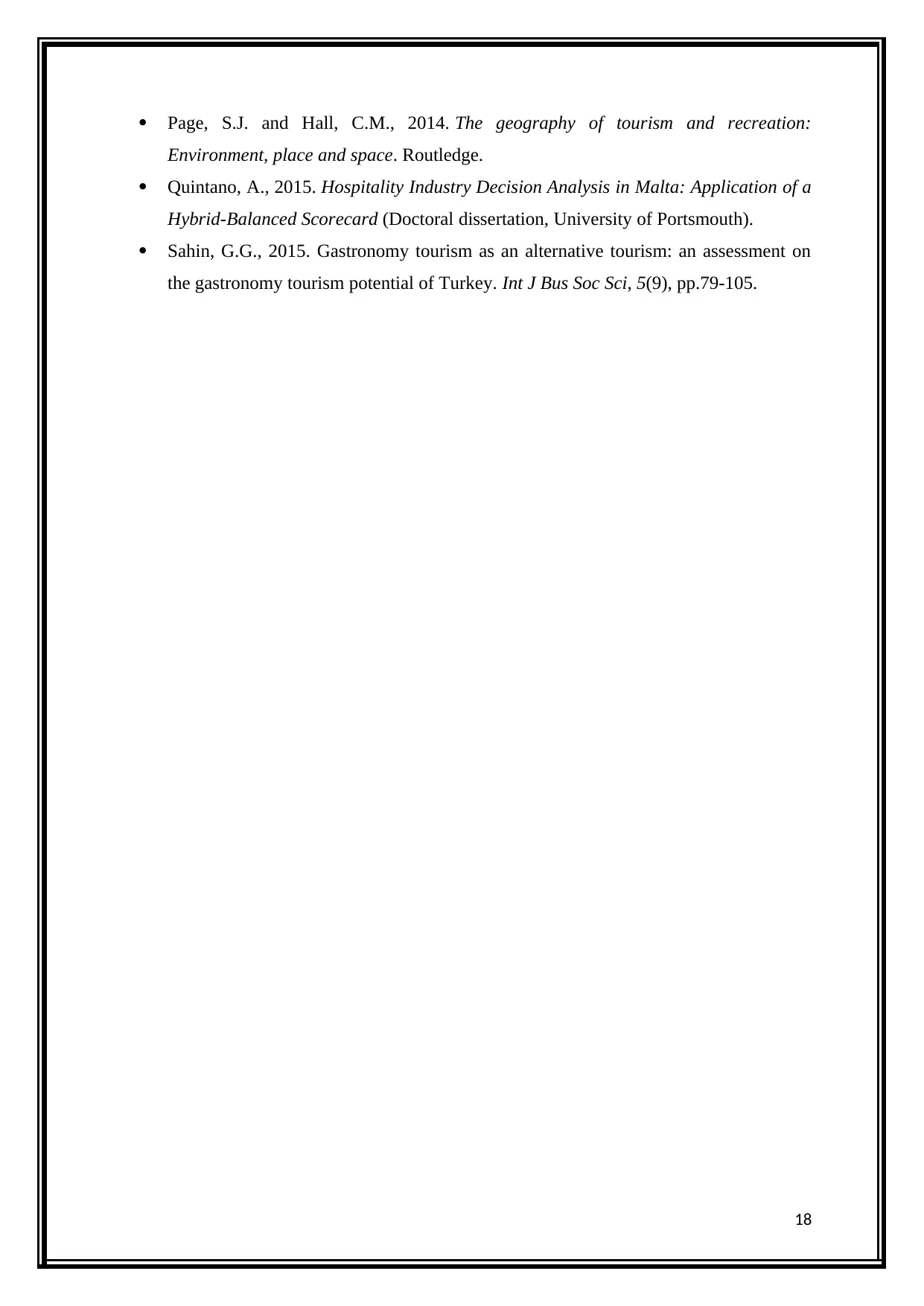
Page, S.J. and Hall, C.M., 2014. The geography of tourism and recreation:
Environment, place and space. Routledge.
Quintano, A., 2015. Hospitality Industry Decision Analysis in Malta: Application of a
Hybrid-Balanced Scorecard (Doctoral dissertation, University of Portsmouth).
Sahin, G.G., 2015. Gastronomy tourism as an alternative tourism: an assessment on
the gastronomy tourism potential of Turkey. Int J Bus Soc Sci, 5(9), pp.79-105.
18
Environment, place and space. Routledge.
Quintano, A., 2015. Hospitality Industry Decision Analysis in Malta: Application of a
Hybrid-Balanced Scorecard (Doctoral dissertation, University of Portsmouth).
Sahin, G.G., 2015. Gastronomy tourism as an alternative tourism: an assessment on
the gastronomy tourism potential of Turkey. Int J Bus Soc Sci, 5(9), pp.79-105.
18
1 out of 18
Related Documents
Your All-in-One AI-Powered Toolkit for Academic Success.
+13062052269
info@desklib.com
Available 24*7 on WhatsApp / Email
![[object Object]](/_next/static/media/star-bottom.7253800d.svg)
Unlock your academic potential
© 2024 | Zucol Services PVT LTD | All rights reserved.





